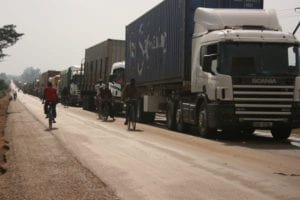Apart from linking the land-locked countries of Uganda, Rwanda and Burundi with Kenya’s maritime port of Mombasa, the Northern Corridor also serves the eastern part of the Democratic Republic of the Congo (DRC), South Sudan and northern Tanzania.
Because of their heavy reliance on the Northern Corridor for their overseas trade, as well as trade among themselves, Burundi, the DRC, Kenya, Rwanda and Uganda are contracting parties to the Northern Corridor Agreement. The agreement provides the legal framework for collaboration among these countries on matters to do with transit transport, customs control, documentation and procedures, as well as the development of infrastructure and facilities relating to sea ports, inland ports and waterways, roads, railways, pipelines and border posts. Port of Mombasa The Port of Mombasa is a major maritime gateway to East Africa. Most of the hinterland countries are connected to Mombasa through the Northern Corridor, which explains why Malaba and Busia (on the Ugandan border) are the two busiest border crossings on the Northern Corridor. More than 600 trucks cross daily from Kenya to Uganda at Malaba. Looking at the combined figures approximately 300 000 trucks cross the Malaba and Busia border posts every year. A single customs territory at the Port of Mombasa has improved efficiency enabling transit cargo to be cleared within a shorter time. The East Africa Community (EAC) adopted a regional approach for reducing border-crossing delays by transforming the borders posts on the priority regional transport network into one-stop border posts (OSBP). Under the OSBP modal adopted in EAC, exit procedures take place on the entry side, with the trucks proceeding directly through the customs area on the exit side of the border to the entry side. A regional agreement provides the framework provides the framework for extra-territorial jurisdiction of border management agencies, allowing for joint controls on only one side of the border. Transit of containers from Mombasa to Kampala has been reduced from 18 days to four, from Mombasa to Kigali from 21 days to five and from Eldoret to Kampala from three days to eight hours. Road network The entire Northern Corridor network stretches across 8 600 km. Road transport is fully liberalised, accounting for more than 70% of the total transit flow of traffic within the corridor. Key transit transport routes are from Mombasa to Bujumbura (the south-west terminus) covering 2 000 km of road and the Mombasa Kisangani Road covering 3 000 km. The bulk of imports and exports destined to and from the countries in the corridor are transported through either of these transit routes. Trade deal facilitating trade In February, a US$25 million (R269.75 million) funding deal aimed at facilitating trade along the Northern (linking Rwanda to Mombasa ports) and Central (to Dar es Salaam) corridors was signed by TradeMark East Africa (TMEA) and the US. TMEA said in a statement that this agreement will also focus on facilitating regional integration. The statement added that the support will help TMEA broaden its regional integration programmes at both the ports of Mombasa and Dar es Salaam as well at the key border posts along the Northern (Kigali-Kampala-Mombasa) and Central (Kigali-Dar es Salaam) corridors. TMEA will also work with the East African Community (EAC) member states to remove the remaining barriers to trade. These include high customs fees, corruption, weighbridges, bad roads and delays at border posts.Removing barriers to cross-border trade can reduce the average time to import or export a container from Mombasa or Dar es Salaam to Burundi, Rwanda and Uganda by 15%.
Single customs territory There have been many new developments on the Northern Corridor route, linking Kenya’s port of Mombasa to Uganda, Rwanda, Burundi and the eastern DRC, over the past few months. The changes are all aimed at improving the flow of goods to the landlocked countries, especially Rwanda, Uganda and Burundi. The Northern Corridor has been characterised by delays in clearing and transporting goods, congestion at Mombasa and rampant loss of containers. The government of Kenya has removed roadblocks and reduced weighbridges. These changes have helped traders cut costs in several ways. In the past, clearing agents in Kenya would charge for clearing goods in Mombasa, the Ugandan agents would also charge while crossing into Uganda and finally the Rwanda agents would also charge as well. Each of the three transactions cost money: approximately US$300 per container in Kenya, US$100 to US$200 bond fee per container in Uganda and about the same bond fee in Rwanda. This is in addition to local clearing fees of US$100 per container. This would equate to a trader having to pay over US$800 on clearing fees alone to have goods delivered from Mombasa to Kigali. However, with a single customs territory in place a fixed rate per container is now in place, costing between US$300 and US$400 each, in essence reducing this cost by 50%. It is also envisaged that removing roadblocks and checkpoints between the borders will minimise incidents of corruption. This is because local officials along the routes have been in charge of the roadblocks that have been taking the bribes. Therefore the maximum number of days a truck should spend on the road from Mombasa to Kigali should be five days. It used to be weeks due to the various roadblocks and weighbridges along the route. Northern Corridor transit and transport agreement The Northern Corridor Transit Transport Coordination Authority (NC-TTCA) is an intergovernmental organisation established under the Northern Corridor Transit and Transport Agreement, which was signed in 1985 with the primary focus of facilitating trade and transport among its member states using the Port of Mombasa. The treaty came into force in 1986 with the DRC joining the agreement in 1987. Due to the recurring challenges faced by the users and regulators along the Northern Corridor Transport system, the NC-TTCA conducts periodic surveys to identify and address non-tariff barriers along the Northern Corridor in order to come up with recommendations that encompass the views of the public and private sector players along the corridor. The surveys are conducted by a multidisciplinary survey team comprising both public and private sector stakeholders involved in the handling and clearance of goods along the corridor. Regular updates can be obtained on www.ttcanc.org. These surveys look at the physical transport infrastructure and facilities in place, procedures for handling and clearance of goods along the corridor, examine the cargo and people clearance processes at the border stations, and hold one-on-one and plenary sessions with the relevant stakeholders operating at the transit nodes visited (border stations, ports, ICDs and parking yards). The last stakeholders’ survey along the Northern Corridor at time of going to press took place during September 2013, covering the transit sections of Eldoret-Malaba, Malaba-Elegu/Nimule via Soroti and Gulu, and Elegu/Nimule-Juba. This is situated in the south Sudan region and affects containers from the Port of Mombasa. For the full report, visit www.ttcanc.org.







